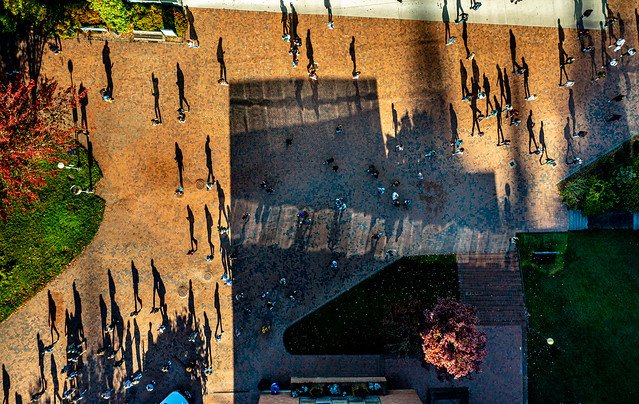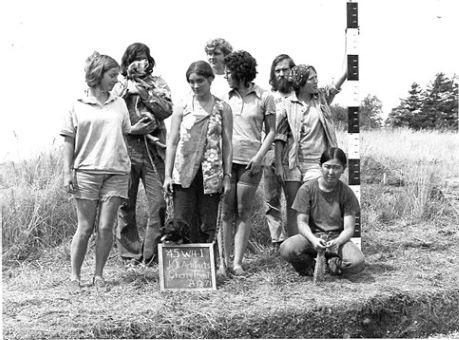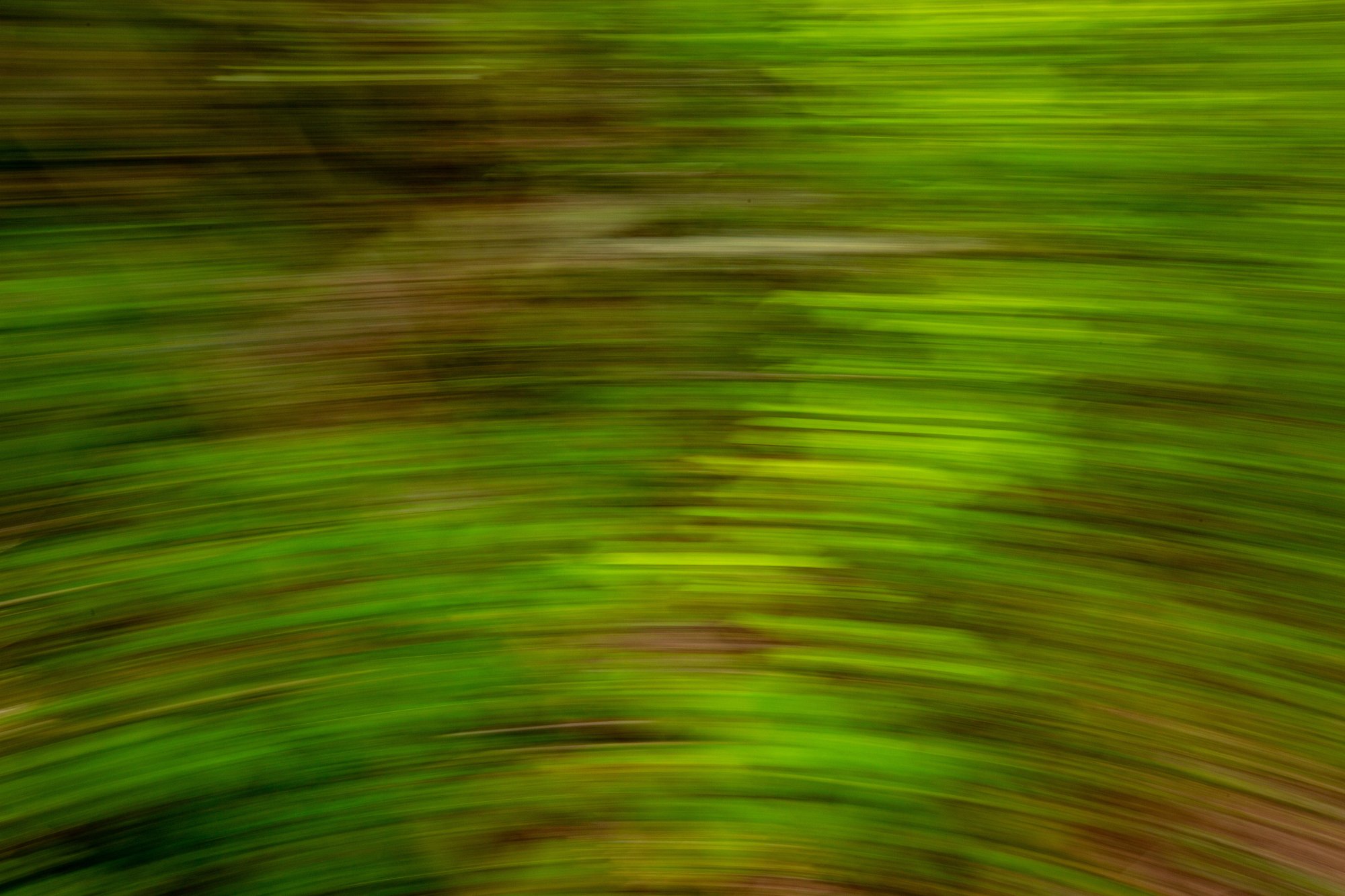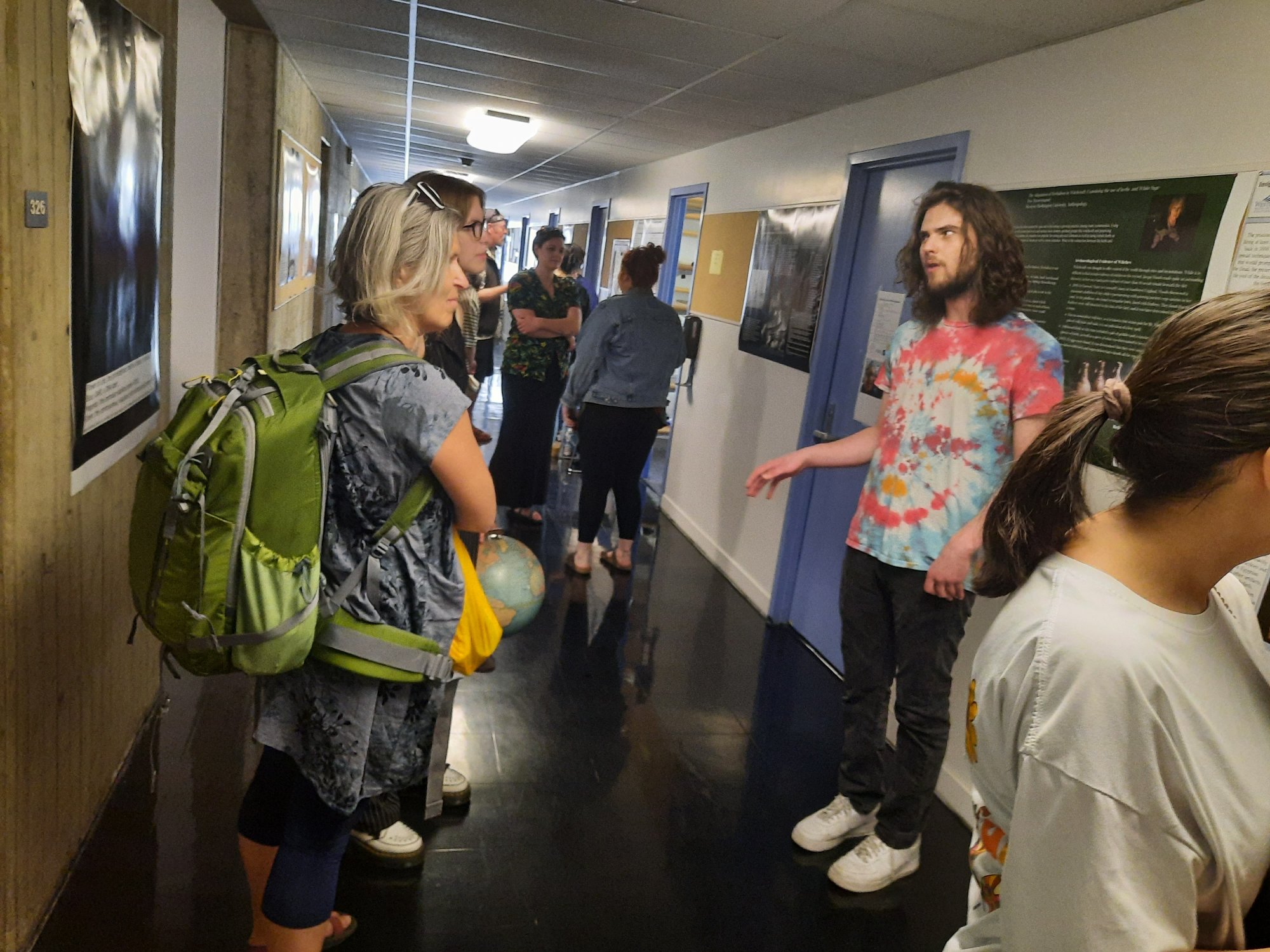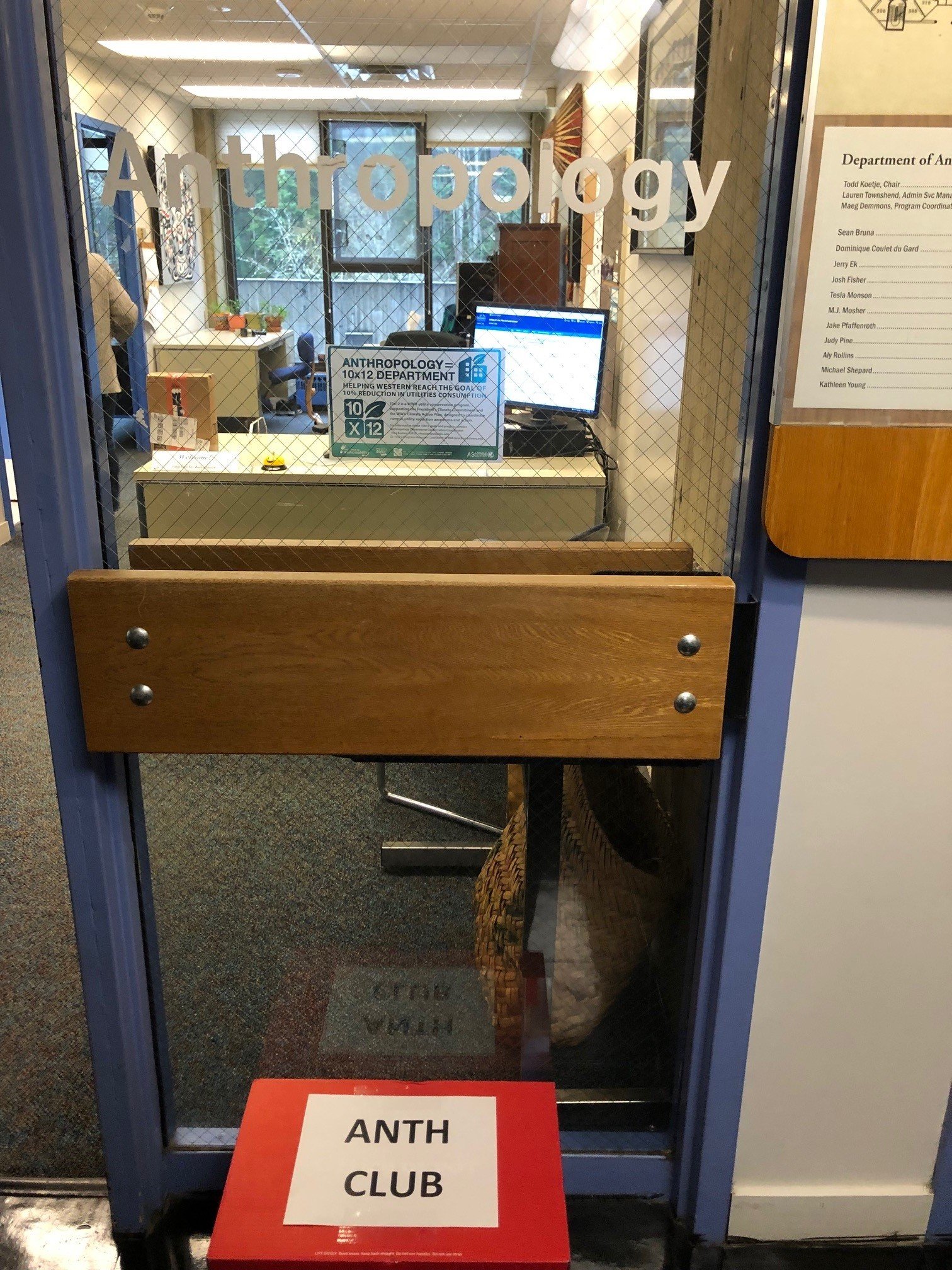Anthropology Newsletter 2023-2024

Read more about x̌ʷiq̓ʷix̌ʷalqʷuʔ
(Blue Water) Archaeological Project 2023
Learn more about Archaeology Field School

Read more about Jack's experience in D.C.
Message from the Chair Dr. Judith Pine
You’ll read in this newsletter about the various activities and accomplishments of the faculty, students, and alumni of the department. Rather than reiterate this I wanted to provide a brief overview to bring all of this work together.
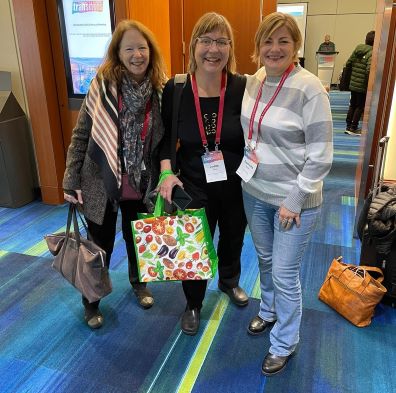
American Anthropological Association Conference
in Toronto November 2023
This year we have welcomed three new faculty into the Anthropology Department and I have been thinking about the changes I have seen in the department as I begin my 16th year here at Western, and about what remains the same. When I arrived it was especially important to me that I was joining a four-fields anthropology department at a university with a strong climate of interdisciplinary interaction. It seems to me that Anthropology’s strength is our internal interdisciplinarity which supports external interdisciplinary relationships while retaining our shared disciplinary identity. While most of the folks I joined at Western in Fall 2008 have retired or in some cases passed away the faculty who have joined us retain this four-fields focus. As our students will remember we ask you to reflect on the anthropological skills you have acquired in your time with us. I love to see these anthropology skills in action in classes and in posters and presentations and hallway conversations! As I talk with my colleagues about work their students are doing I look forward eagerly to our upcoming Scholar’s Week conference in Spring. I am also excited about the inclusion of faculty presentations in the Anthropology Club offerings – I had a lot of fun presenting on memes this quarter! I rely on my four-fields anthropology training for many of the tasks of being department chair as well, not least of these the ongoing work of the WWU NAGPRA Committee as we move steadily towards our shared goals with regards to our collections.
The chair gig is in no way boring, but I have found time to do a bit of scholarly work. This summer I attended the International Pragmatics Association conference, where I was part of the linganth contingent at a gathering of a wide variety of scholars of language and meaning. In the Fall, I attended the American Anthropological Association conference, where I was again part of the linganth contingent among my disciplinary kin from all of the subdisciplines and specialities. In both cases I was reminded of the importance of the Anth part of my LingAnth identity. At IPrA and at AAA I returned to Lahu media project work. I completed final revision for publication of a book chapter drawing on my Lahu research as well. Meanwhile I am working with colleagues on a book for which my contribution addressed the semiotics of a particular component of Thai political protest and its spread through other countries in SE Asia and starting a project with a Thai friend focusing on Northeastern Thai migrant workers in Singapore. While the time required for research and writing can be harder to find now that I have a few more hats (I feel a bit like Bartholomew Cubbins sometimes!) the fact that my colleagues are actively engaged in so many interesting projects creates an environment that is conducive to scholarly productivity.
Anthropology as a discipline has undergone and continues to undergo change and the Western Anthropology Department is engaged in this change as we attend to and reflect on our colonial past and move from intention to action towards not simply reacting to the past but actively building our future. You’ll read about this in some of the other notes in this newsletter. There will continue to be news from the department as we move forward.
I am honored to have the opportunity to serve as chair of this vibrant, engaged, committed department and am excited to see what we accomplish together in the coming year!
Leveling Up: Q&A with Archaeology Senior, Adrena Hamilton
As a former corporate leader, long term volunteer and participant in the US Forest Service (USFS) Passport in Time and field school participant, Adrena Hamilton used her breadth of experiences and archaeology education to make inroads into an archaeology career. Adrena will start in her permanent position as an Archaeology Tech for USFS this summer 2024.
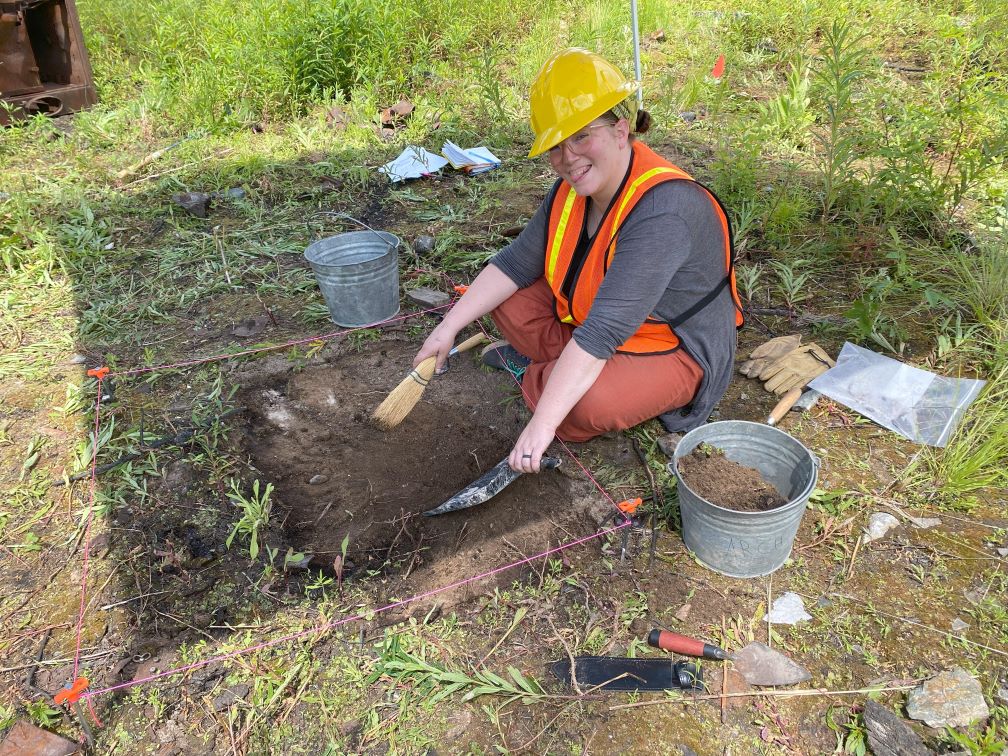
What drew you to the field of archaeology?
Volunteering has been such a central part of where I am at today. I don’t like to go into anything blind, and volunteering is what gave me that insight to know what real-world archaeology is like. I loved field school in Belize, but the USFS program has done far more to prepare me for the next step than just field school alone. There are some forests that even accept volunteer experience as field school experience or even give preference to those who have volunteered. I’m very excited to have the opportunity to work in the same forest that I worked on my first archaeological site, my first excavation, and where I decided to become an archaeologist.
I’ve loved history since I was a child, and archaeology is such a tactile way to explore and experience the past. History is not only written by the winners but the people at the top, and archaeology has the ability to tell the stories of people who can no longer tell it themselves. I think that the more we can make those voices relatable, the easier it is to make change today for those who need it.
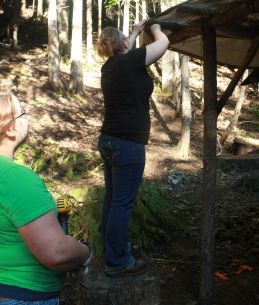
Powder House Restoration
What stands out to you from your academic undergraduate experience as particularly useful in the field or workplace?
I love that the anthropology department works together as a whole. The department feels bigger because no matter what the specialization, all of the professors have unique insight in to whatever I am interested in. On a more practical level, rarely does one live in a box when they enter the workforce. Working with other teams and departments is necessary anywhere you go, and sometimes great resources are outside your comfort zone.
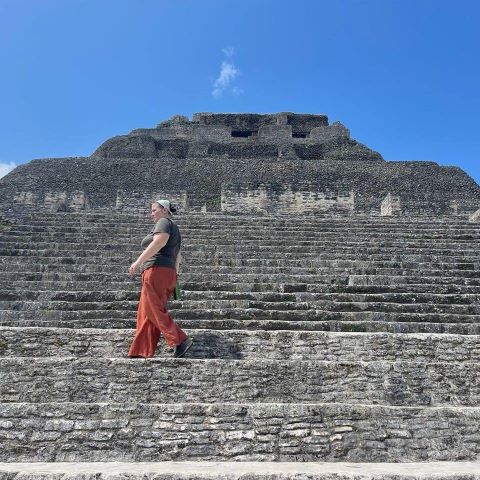
Tell us about a project you are especially proud of. What were the highlights and challenges?
When working on a restoration project I hewed a log on my own with a broad ax/broad hatchet. I was in pain for a week, but I have never felt more empowered in my life.
What advice do you have for undergraduates majoring in anthropology?
One of my favorite quotes is by Dave Grohl; “You are you, and that is your superpower.” I have often found that it’s not how well I fill the requirements that puts me over the top, but everything else that I bring to the table. In reality, for any position there are going to be things that teams want to fill that’s not necessarily related to the position, and sometimes they don’t realize they need it until they see it. Most likely there will be many applicants that can do the job, so the deciding factor is what is unique to you. There was a communications internship that I landed not because I had the best portfolio, but because I also came with project management experience. I have hired for positions sometimes wanting experience and sometimes not or had to balance experience with budget. A museum I interned at looks for customer service and camp counselor on the resume because it shows the ability to handle groups of children for several hours. Don’t ever assume that any experience is not relevant. Secondly, mental health is important. I have grinded away for years to make progress, but it was only after I prioritized my mental health that I not only started to get somewhere, but it got easier.
Data Collection at the Smithsonian by Jack McBride, Graduate Student- Anthropology MA

During this past Summer, 2023, I was fortunate enough to travel to the Smithsonian National Museum of Natural History in Washington, DC with my advisor, Dr. Tesla Monson. While there we worked in the Mammal Collection. I was using the Primate Evolution Lab's Artec Space Spider 3D Scanner to scan primate crania and mandibles. I ended up obtaining samples of orangutans and other apes, many leaf-monkeys, and a selection of American monkeys (the last of which I am using in my thesis research). Beyond this experience in museum data-collection, we had access to the exhibits before the museum opened and received tours and instruction from curators in the Mammal Collection

Steps of the Smithsonian
We learned that President Theodore Roosevelt collected a number of the collection's leaf-monkeys (among other animals) on a collection trip shortly after his time in office. I was discussing expeditions with Collections Manager Darrin Lunde, and he told me that many of the samples collected by John Steinbeck (described in his fantastic book, "The Log from the Sea of Cortez") were located on the same floor as the collection where we were working.

I was also trained in using the Artec Micro 3D scanner and got to meet other early-career academics including a PhD candidate from Johns Hopkins and a Postdoctoral researcher who started at the Smithsonian just a week after we arrived. I had never been to Washington, DC before and I had a great time seeing a new city while learning invaluable skills.
CEDAR 2023
Anthropology Student Papers
Tegan Keyes, Honoring the Gift: An epistolary exploration of an alternative approach to learning grounded in reciprocity and gratitude, undergraduate paper
Kelsey Maloy, Culturally Modified Trees in Western Washington: Impact and Perspective from the Stillaguamish Cultural Resources Department, graduate thesis paper
Update to Last Year's Alumni Spotlight:
"I am happy to say I have officially graduated as of last month from Utrecht University (UU), Netherlands, with my MA in Gender Studies! After an intense one-year program I learned so much about decolonization, somatics, intersectional thinking, and critical understanding. My internship concerned helping people in the Netherlands navigate the healthcare system more easily regarding their reproductive health. It has been quite the year!"- Eliza Hortegas, Class of 2021
A Tight-Knit Group of MA Alums: Where are they now?
2016-2017 Anthropology MA alums Tiffany, Katie, Katarina and Marinel maintain connections with each other and emeritus faculty member, James Loucky (who came back to teach Borderlands fall 2023). Professor Loucky reached out to these former students for their updates.
Tiffany Ayala. Since earning her MA, Tiffany Ayala has worked at Lydia Place, a non-profit organization that provides parenting and mental health support for over 400 families in Bellingham. Serving first as housing case manager, and currently as housing director, Tiffany is responsible for managing wrap-around services for any family having one or more children. These include rapid re-housing for emergency situations along with longer-term/permanent housing, in keeping with a basic mission of disrupting the intergenerational cycle of homelessness.
Katie (nee Falwell) Goger is a Licensed Independent Clinical Social Worker (LICSW), working as the Pediatric Social Worker at the Lummi Tribal Health Clinic and in her small private practice in family therapy. She continues to enjoy working with indigenous families at Lummi, where she has been since 2012.
Katarina Gombocz is working towards an endorsement in Multilingual Education through WWU, a founding member of the local group Whatcom Families for Justice in Palestine, and spends time in animal and garden cooperatives with dear friends, practicing with Red Cedar Zen Community, and watching bad reality TV.
Marinel Kniseley has applied her graduate degree from WWU through involvement in a number of research and service projects in southern British Colombia. As research manager at the University of the Fraser Valley, she has coordinated projects relating to impacts of COVID for newcomer community members and farmworkers, as well as options for both long-term and temporary support. Her participatory research also focuses on youth experiencing multiple challenges, such as aging out of services. She exemplifies commitment to involving youth as mentors, having voices and experiences that are invaluable in overcoming common obstacles for turnover and poor outcomes.
Thank you for sharing!
New Professors in 2023
Dr. Mariangela Mihai is a sociocultural and visual anthropologist and filmmaker whose work builds on decolonial, intersectional feminists, and sensory ethnographic methods to understand Christian Indigenous resistance on the India-Bangladesh-Myanmar borderlands. She served as a Postdoctoral Fellow in Global Media and Film, in the Culture and Politics Program (CULP) at Georgetown, an interdisciplinary program that focuses on questions of power and inequality, globally. Her interdisciplinary and multimodal research, transnational teaching and activism, and long-term commitment to engaged pedagogy and public scholarship have led her to this position, as an Assistant Professor in Anthropology at WWU.

Dr. Marianne Brasil is a biological anthropologist who studies skeletal evolution and variation in humans and monkeys. Her research spans work in the field, museum, and lab to investigate human origins. She is thrilled to be joining the vibrant faculty in the Anthropology Department at Western in the fall of this year, and is excited to work with Western students and welcome them into her lab!
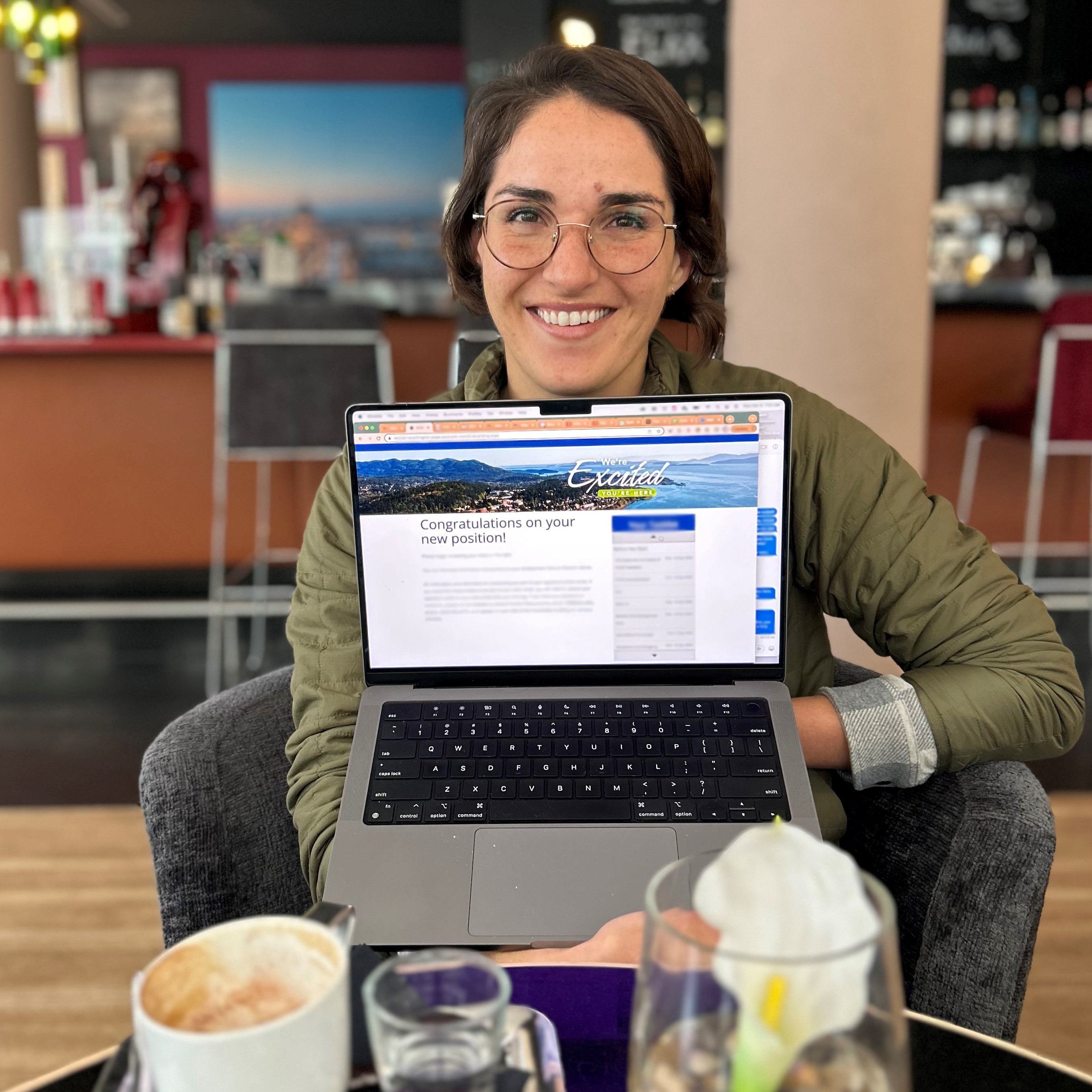
Dr. Jerald Ek (Jerry) is an archaeologist with research interests in community-based participatory research, indigenizing archaeology, human-environmental interactions, and political economy. After spending most of his career focusing on the Maya Lowlands region of Mesoamerica, he has shifted focus to the Salish Sea region.
Professor Sean Bruna named Senior Advisor at the U.S. Department of Health and Human Services
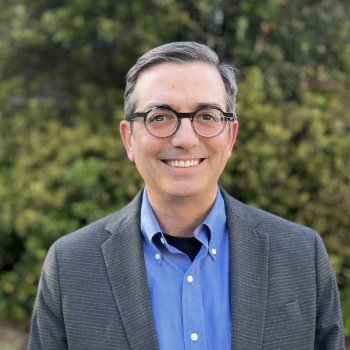
The Department of Anthropology is proud to announce that Associate Professor Sean Bruna has taken leave from Western to serve in the Biden-Harris Administration as a Senior Advisor in the Office of the Director of the Agency for Healthcare Research and Quality (AHRQ) in the U.S. Department of Health and Human Services (HHS).
AHRQ is the lead federal agency charged with improving the quality and safety of healthcare in the United States. AHRQ addresses aspects of health service administration, such as producing and examining evidence in real-world settings, disseminating actionable knowledge for use by health system leaders and providers of care, and monitoring the functioning of healthcare nationally. As Senior Advisor in the Immediate Office of the Director at AHRQ, Prof. Bruna will assist the Director with various patient experience and safety initiatives.
Prof. Bruna specializes in medical anthropology, health policy, chronic disease prevention, and community-based participatory research. He was a seven-year fellow with the Robert Wood Johnson Foundation Center for Health Policy at the University of New Mexico, where he participated in intensive research and training focused on interdisciplinary and cross-methodological health disparities research for Latinx and Indigenous scholars.
In addition to RWJF, his research has been funded by the Andrew W. Mellon Foundation, the National Center on Minority Health and Health Disparities, Smithsonian Institution Museums of American History and American Indian, and Western Washington University.

In memory of Sarah Campbell
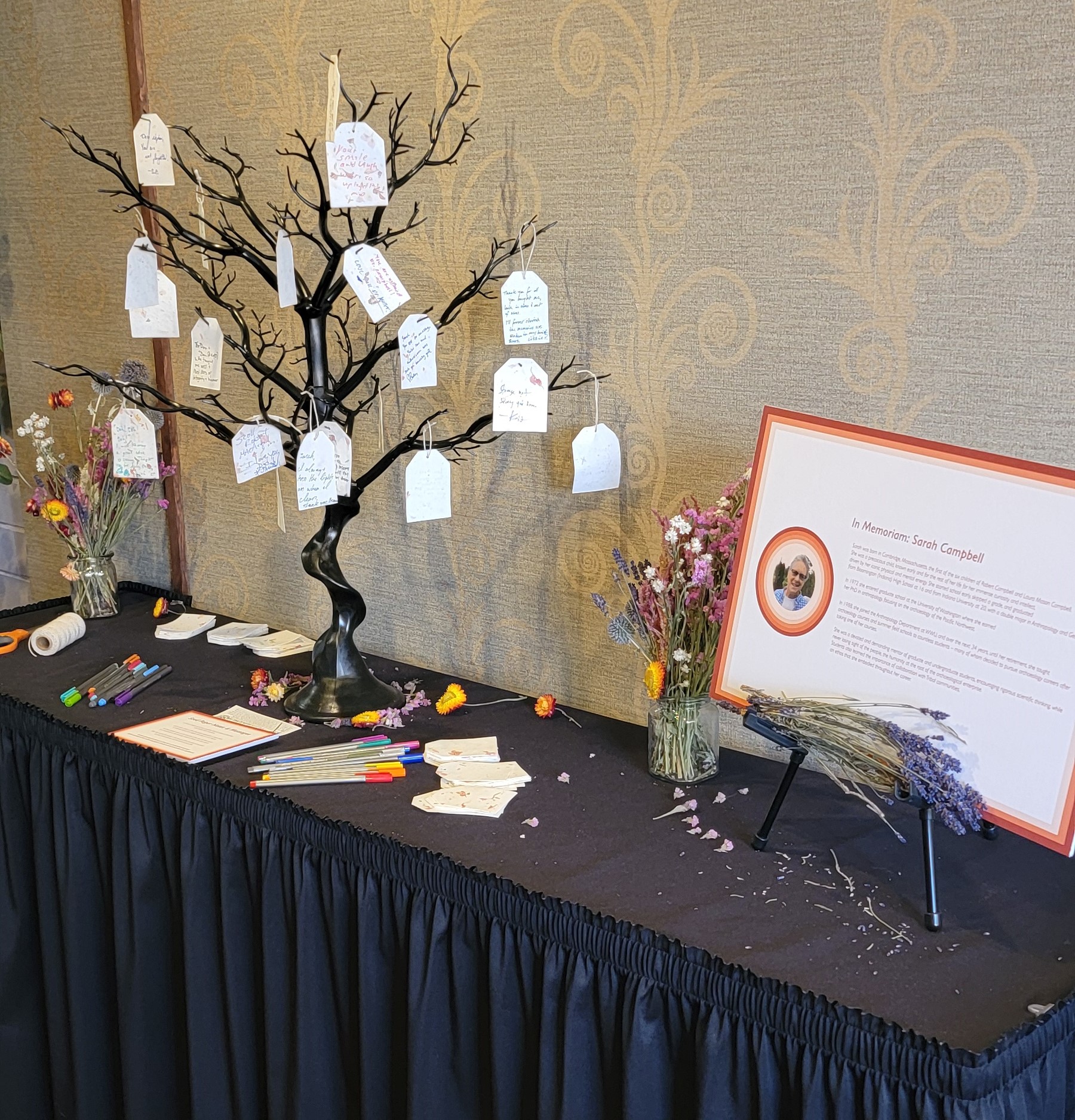
The late Professor Emerita Sarah Campbell (1951-2024) was a tireless and dedicated researcher, colleague, and friend. She made substantive contributions to archaeological scholarship in the Pacific Northwest throughout a professional career spanning six decades. In a dedicated in memoriam session during the 77th annual Northwest Archaeological Conference, arranged by Dr. Jerald Ek and Dr. Todd Koetje, colleagues and friends will come together to share the results of work conducted in collaboration with Sarah or influenced by her lasting contributions to our region’s history and cultural heritage.

Development of an Indigenous-led Archaeological Partnership" as part of the In Memoriam Session for Sarah Campbell.

Tesla Monson, Primate Evolution Lab: Highlights from BIO-ANTH
Happy Newsletter Everyone!
I can’t wait to tell you about the all the exciting things that the Primate Evolution Lab (PEL) has been up to here at Western and around the world!
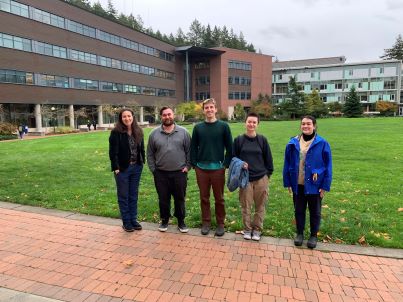
First off, I want to congratulate Mia Price on successfully defending her thesis and completing her MA degree! Mia’s project, Body by Colonialism, looks at the erasure of sexual minorities from forensic and medical protocols. She is also the first PEL student to finish the MA program. CONGRATULATIONS Mia!!
I also want to welcome Jewel Curtis into the lab. Jewel completed her undergraduate degree at Texas Tech University and is interested in forensic anthropology, toxicology, and medico-legal standards. Jewel also works in the coroner’s office in Skagit Valley. We are excited to have Jewel working with us in the PEL!

her successful defense
Over the summer, Jack McBride used funds from his successful Graduate Student Research grant application ($1,500) to take an R coding workshop. He also spent 5 weeks 3D surface scanning primate skulls at the Smithsonian’s National Museum of Natural History in Washington, DC. Following his work at the Smithsonian, Jack submitted an application to the National Science Foundation Graduate Research Fellowship Program. It was an excellent application – fingers crossed for Jack as he waits to hear the results about this application and several others to PhD programs. Jack will be headed to Los Angeles in March to present his thesis work at the American Association of Biological Anthropology meetings. I am looking forward to seeing his presentation!

Tristen Hansen also spent the summer working on his thesis, as well as working as a TA for the Archaeology Field School. Tristen’s research stands to transform the way that archaeologists and biological anthropologists interact with the skeletons of companion animals that are found in archaeological burials. Tristen’s compassion, patience, and perseverance have led him on a winding journey of gathering information, talking to Lummi Tribal members, and developing new oversight protocols for working within archaeology. Tristen was recently awarded the Graduate Student Research grant from WWU ($1500) to support his research and will be presenting his thesis work at the Northwest Anthropological Conference in Portland in March 2024.
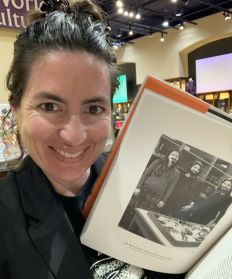
the Bearded Lady Project book
at the Smithsonian
I also want to recognize Laura Smith for all their hard work in the Primate Evolution Lab. Laura is an exceptional undergraduate who has been working on a mammalian osteology project with Alyson Rollins. Laura is also an important part of the PEL community. Laura was recently awarded an Undergraduate Student Research grant from WWU ($750) to fund a trip to the Museum of Vertebrate Zoology in Berkeley to 3D scan hand and foot elements of Pacific Northwest mammals.
As we recognize members of the Biological Anthropology community here at Western, I want to extend a warm welcome to our newest Assistant Professor, Dr. Marianne Brasil. Marianne joins us from the Human Evolution Research Center and the Berkeley Geochronology Center in California. We are extremely excited to have such an exceptional paleontologist here on staff, and the students are already singing praises about her Osteology class.
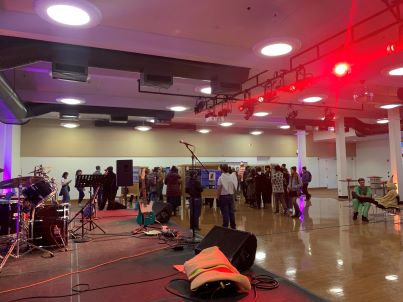
I have been collaborating with Marianne for many years, and I look forward to our ongoing and future work together. Earlier this year, we published 3 papers describing almost 1,000 monkey fossils from Ethiopia, one of which was featured as the cover of the American Journal of Biological Anthropology. And in June, the National Science Foundation funded our grant application for $556,000 to investigate the evolution of the primate eye orbits and face. With this grant funding, we are hiring a postdoctoral researcher, supporting an MA student through a 1-year funded research position, and hiring several undergraduates to work with 3D scans in the lab.

sculpture outside CENIEH
Our NSF grant also provided funds for me to spend 2 months in Burgos, Spain, over the summer, working with collaborators at the Centro National de Investigación sobre la Evolución Humana (CENIEH). While in Spain, I got to visit Atapuerca, the famous fossil site where the earliest members of genus Homo are found in Europe. I also toured their incredible lab facilities, saw the oldest cave art in the world, interviewed Dr. Nina Jablonski about her research on skin for a podcast, and took a safari trip to the Paleolithic animal park where researchers have combined ancient DNA with modern DNA to ‘resurrect’ extinct animals. It was an exhilarating summer to say the least!
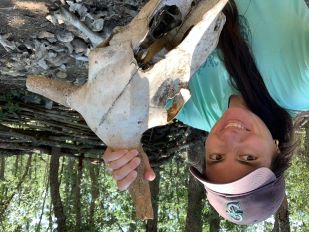
On the curriculum side, I want to give a shout out to all the students of ANTH 320 Skeletons and the Occult who presented their original research in the Viking Union on Halloween. There was live music, animal bones that students could hold, and 25 lbs of candy that was somehow all gone in the end. We have also been getting some very cool demonstrations of both the 3D surface scanner and the new micro-CT scanner that was funded by a recent NSF (I am a co-PI).

micro-CT as applied to teeth
We can’t talk about all the amazing things that we have been doing here at Western without recognizing the incredible legacy that Dr. Sarah Campbell leaves behind. If I can create opportunities for even 1/10th of the students that Sarah mentored and helped and encouraged, I will feel content in my academic career. Sarah was an incredible scientist, friend, mentor, and colleague. And she still lingers here in the hallways, as I hope she will continue to do for many years.
Jerry Ek, Notes from Archaeology: An Indigenous-Led Project
The last year has been a hectic period of transition. The program and broader community have been struggling with the passing of Sarah Campbell. Sarah was my undergraduate advisor, mentor, and friend, and the loss has been particularly difficult as we plan for the post-Sarah chapter of the archaeology program. However, I feel very fortunate to be part of the program that has seen an influx of talented new faculty. It feels like the beginning of a new chapter for both my own career and the department.
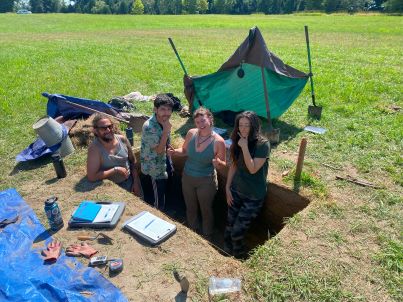
(Blue Water) site
Last summer we conducted the second field season of an indigenous-leg program in collaboration with the Stillaguamish Tribe of Indians. The x̌ʷiq̓ʷix̌ʷalqʷuʔ (Blue Water) Archaeological Project is a community-based participatory research program centered on local knowledge, tribal priorities, capacity building, and promotion of Indigenous sovereignty over places, belongings, and intellectual property.
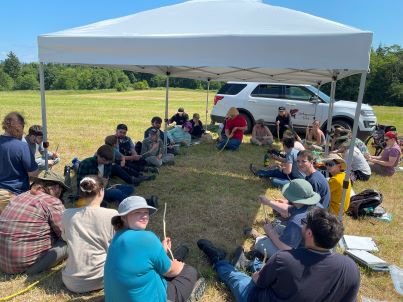
The creation of the program involved reorientation of the WWU Archaeological Field School as an Indigenous-led program. I serve as a co-director with three colleagues from the Stillaguamish Tribe Cultural Department. Our goal for the second season focused on relationship building, connecting the past with the present, and building upon the foundation created the previous year.
The 2023 field season of the x̌ʷiq̓ʷix̌ʷalqʷuʔ Project involved continuing a survey initiated in 2022 and starting work at a new location along the North Fork of the Stillaguamish River. I am pleased to announce that we will be continuing this work in 2024. I cannot sufficiently express my gratitude to the Stillaguamish Tribe for their generosity in sharing their wisdom, culture, and history. Participating in this collaboration has been the most rewarding experience in my career.
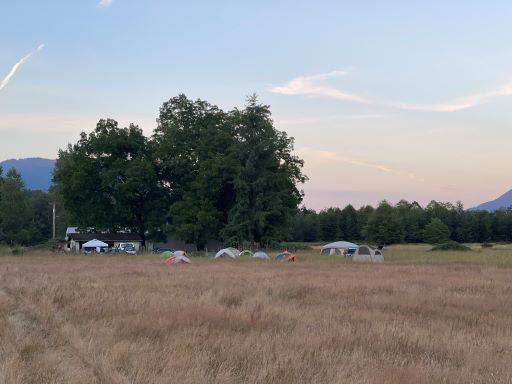
the Stillaguamish River
While I have shifted my primary research focus from Mesoamerica to the Salish Sea, I continue to work towards finalizing and disseminating the results of my last project in the Maya Lowlands. The plan is to conduct a few short field seasons in Champotón, Campeche to finalize a long-term regional project. I’ve also been involved in the development of a machine learning platform to identify archaeological features survey data generated by aerial laser scanning.
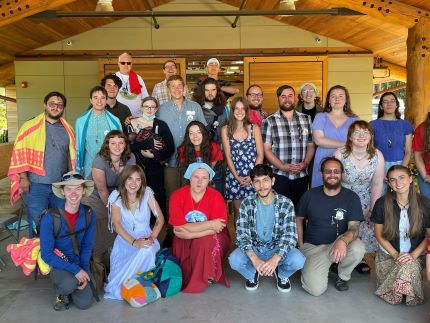
of the x̌ʷiq̓ʷix̌ʷalqʷuʔ (Blue Water)
Archaeological Project
This AI platform would streamline the process of identifying and delineating ancient structures and landscape features from LiDAR-derived datasets.
This project has been a collaboration with faculty and students from WWU’s Computer Science Program. We recently gained access to new sources of LiDAR survey data from southeastern Mexico. The expansion of this project will provide opportunities for students in both the Anthropology and Computer Science Program.
Yeon Jung Yu, A Year of Sabbatical: Medical Anthropological Research, Travel and Collaboration
During my professional leave, I visited Seoul National University (SNU) and networked with local scholars. Because I left South Korea many years ago and have been living in the US, I experienced counter-culture shock when re-immersing myself in the society. I gave invited talks at the Korean Medical Anthropological Association, Kyungpook National University, and two NGOs (Center for Sexual Rights and Reproductive Justice; Sexworker Liberation Action Movement Scarlet ChaCha). In addition, I presented for the conferences at the 2022 Society for Applied Anthropology’s Annual Meeting (SfAA) and the 2022 American Anthropological Association (AAA) Annual Meeting.
With collaborators at the Korean Advanced Institute of Science and Technology (KAIST) and Seoul National University Medical School, using various international funding sources, I conducted research projects on undocumented migrants’ health as well as climate change and human mobility. Additionally, our team saw the publication of two WHO reports about the North Korean healthcare system during the pandemic and global migrants’ healthcare for noncommunicable diseases (NCDs) that came out of my leave in Korea. We also produced a journal article on North Korean refugees. Our graduate student, Ms. Hailey Maltempi, has joined the lab and has already earned an authorship for a peer-reviewed journal article. I look forward to continuing the international collaborations in South Korea, including an upcoming trip over the winter break to Seoul for talks at SNU and NGOs to launch interviews for my NSF project on ethical research methodology engaging in disadvantaged populations.
In the summer, I had a chance to travel to China and return to field sites where I conducted research several years ago. It was interesting to see the dramatic changes in and around red-light districts. I was deeply touched by my previous participants-turned-old friends who passionately and warmly welcomed me back. It was the most touching moment of my year.
As a consultant, my collaborators at the University of Massachusetts Medical School and I visited Bangkok, Thailand. The visit and meetings with local collaborators allowed me to understand the local situation and deepened mutual trust/understanding. Our team has produced three manuscripts on HIV risks among Thai LGBTQ+ and Bahamian adolescents. We also gave a conference presentation at the American Public Health Association Annual Meeting (APHA 2022). I presented for the Program in Digital Medicine at UMass Chan Medical School. In addition, Prof. Sean Bruna and I, engaging in our joint teaching of qualitative and quantitative research methods, have continued our collaborative study on recreational drug use among Western students. We are excited to see the fruits of the collaborative research this year!
While on professional leave, I’ve continued to run the “WWU Applied Anthropology Lab” virtually. I’m very proud of our lab members for their active and diligent participation in professional research. Our brilliant students—Patricia Fernandez, Hailey Maltempi, Emma Cox, Ashland Douglas, Fernanda de Oliveira Veiverberg, and Mads Hall—have been trained in cultural and medical anthropological research methods while participating in professional research via regular lab meetings and training sessions. Congratulations to both for graduation and successfully taking their first steps toward their careers! Researchers from the University of Indianapolis and the University of British Columbia have offered extensive collaborative mentoring. As a result of this collaboration, a book chapter in an edited volume on erotic labor in the 21st century is forthcoming through the NYU Press. I’m proud to share that our undergraduate members earned authorship for the 2022 and 2023 Law and Society Association (LSA) annual meetings oral presentation. Most of our lab members have also participated in writing projects for peer-reviewed journal articles. I’m excited about this upcoming year to be another productive one for our lab members!
Last but not least, I’m looking forward to this year’s development as the director of our Graduate Program and continuing the legacy of previous directors, Profs. Sarah Campbell and Sean Bruna. Here’s to another year of innovative collaborative research partnerships as well as new teaching and serving opportunities at Western and beyond!
Kathleen Z Young, Trauma & Recovery and Anthropology at Home: The Senior Seminar Experience
After twenty years, the upper division 490 course, Trauma and Recovery, retired in its prime. Lily Berver’s paper “Gender and Repression in Argentina’s Last Dictatorship” won the department’s research award and Lily won a Fulbright to teach in Argentina. Two additional 490 students shared their work during Scholar’s Week. Adella Machackova’s presentation was on “The other half of drug addiction,” and Lance Tulloch delivered his paper, “Modern Slavery.”

The Society for the Anthropology of Consciousness, a division of the American Anthropological Association, came to Bellingham for their 40th Annual Conference. This year’s theme was death and transformation, an appropriate venue for Lance Tulloch’s paper on necropolitics. In memoriam for the trauma and recovery course and to honor all the students who confronted difficult issues in all my courses, I presented the paper, “Staring into the abyss and bringing the dead and damaged to life in the classroom; twenty-five years of student reflection on witness narrative.” War, trauma, existential threats to existence, and the inevitability of death are subjects which can be difficult to articulate, resisting language at times. I discussed the effectiveness of de-briefing and low stakes writing prompts as a means for students to participate in bearing witness, narrating these overlooked aspects of what it means to be human.
I developed a new 490 course, Anthropology at Home, a class experimentally designed in opposition to traditional anthropology centered on “others.” With an ethnographic sensibility, we focused the anthropological lens on anthropology here, in our corner of the Pacific Northwest asking, in what ways have past generations of anthropologists shaped the present? I hoped the course would help us, “Identify the implications of intersections between coursework and personal experience,” one of the department’s student learning outcomes.
We began with an elaborated land acknowledgement, a review of what we know about the Coast Salish Sehome family and the two women, Xwelas Mary and E-yow-alth Julia, who lived here on land enveloping the campus of Western Washington University before the signing of the Treaty of Point Elliott.
In 1879, Xwelas Mary was on trial, charged with killing an abusive husband. We read through the transcripts of the trial with different students reading the recorded testimonies of different witnesses. Students then reviewed the trial as if they were the jury. They deliberated and concluded it was a clear case of self-defense. She was wrongly convicted, and the 490 class cleared her name, if only in the classroom.
The class visited the Center for Pacific Northwest Studies where students discovered photos of ancestral human remains from a mid-century excavation by the department's first anthropologist, Herbert C. Taylor. Students became witnesses to the violence of the salvage anthropology era through the discovery of these photos, an era when routine practices, upheld by esteemed professionals, are seen differently today.
These are subjects many people may want to avoid, but again, it was my privilege to work with students willing to assess the complexities of past practices and the ways the past may adhere to the practices of academic departments and institutions of higher education today.
KZY, Contact Us: Identifying Students from Professor Grabert's 1970s Archaeology Field School Classes
As part of the process of documenting the past, I came across iconic department photos from the 1970s. The students pictured were important contributors to the pedagogy of anthropology at Western Washington University but with rare exception, no one knows their names.
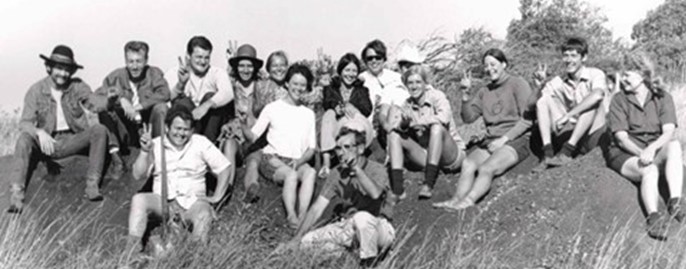



and students
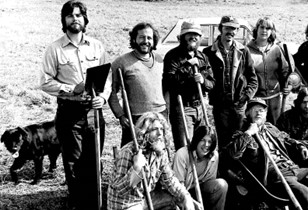
the picture again

Richard Chesmore next to
the black dog with a group
of unknown students
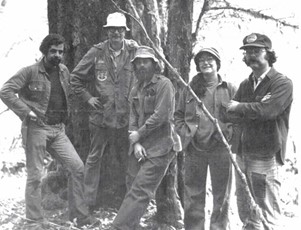
on the right next to
Mary Weed (?)
and unidentified students
Contact Us
Please email us at anthropology@wwu.edu if you recognize any of these WWU archaeology students.
Bonus points for dog identification!
Marianne Brasil, A Wonderful First Quarter at Western
It’s hard to believe that my first quarter here at Western is nearly over! I started in September as a new faculty member in biocultural anthropology and have been enjoying settling into my new academic home. In my first quarter, I’ve been especially struck by the strong sense of community here in the department. I've truly enjoyed getting to know my fellow faculty members, our wonderful staff, and our graduate and undergraduate students – I’m looking forward to growing with you all in the years to come! I’m honored to have the opportunity to build on the deep history and reputation of bioanthropology here at Western.
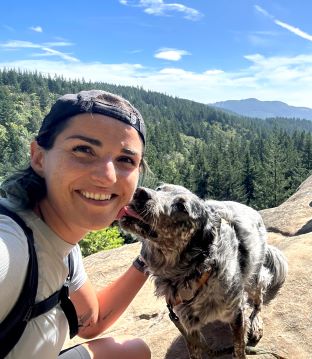
at the Raptor Ridge overlook
in Larrabee State Park
I made the move to Bellingham from Austin, TX, at the end of July – thankfully in time to catch the last bit of the beautiful PNW summer! In Austin, I’d been working remotely as a postdoctoral researcher at the Berkeley Geochronology Center, and then briefly at the Human Evolution Research Center at UC Berkeley. Through most of my postdoc I was working on describing new thousand-year-old monkey and human fossils from the Middle Awash study area in Ethiopia. The three “monkey papers” – as our team came to know them – reporting on the monkey fossils were (finally!) published in the American Journal of Biological Anthropology in January of this year. These papers were the culmination of a very fun and massive group undertaking that involved the curation, measurement, analysis, and description of nearly 1,000 monkeys. Fellow biocultural anthropology faculty member, Tesla Monson, was a wonderful collaborator on this project, and we’re looking forward to continuing this work together as we turn our eyes to another huge sample of half a million-year-old monkeys collected from the same study area.
Alongside my work on monkey fossils, I’ve also been working with colleagues on the Middle Awash Research Project to prepare manuscripts on human fossils from ~100,000 years ago, alongside the archaeological evidence and ecological contexts of these early people. This is a big team effort involving a lot of international specialists, and it has been interesting to see all these disciplines - across paleontology, archaeology, and geology - brought together. Please stay tuned for these forthcoming publications!
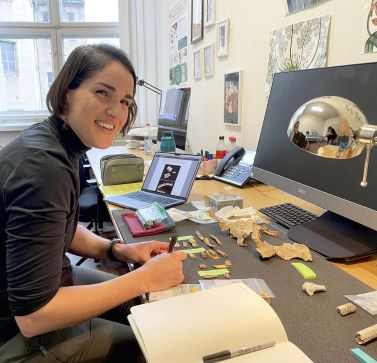
Museum für Naturkunde in Berlin (March 2023)
During my postdoc, I also started collaborating with an international multidisciplinary paleontology field team that has been working in eastern Sudan. With a team of specialists that work on a range of fossil animals, including bovids, pigs, hippos, birds, among others, along with colleagues focused on geochronology and archaeology, we’ve been preparing the initial descriptions of the newly recovered fossils. My small piece of this has been working on the monkey and hominid fossils, which took me to Berlin earlier this year to work with the fossils in-person. I’m looking forward to presenting the initial results of this work next year at the American Association of Biological Anthropologists in Los Angeles, CA, and at the East African Association for Paleoanthropology and Paleontology in Addis Ababa, Ethiopia.
I’ve also been enjoying continued collaborations with Tesla on other research avenues. After more proposal resubmissions than we care to remember, our grant proposal to the National Science Foundation (for ~$550,000) was finally funded earlier this year! This three-year project will investigate how the human cranium has evolved, especially considering the role of the eye orbit in our lineage’s evolution, and how we fit within the variation seen across primates. We’re in the process of hiring a postdoc who will help us mentor and supervise graduate and undergraduate students on the project (in paid positions!). We’re very excited to get this project started, but I won’t say too much more about this – Please take a peek at Tesla’s update in this newsletter for more details!

in Ethiopia (from left to right: vervet monkey, baboon,
and colobus monkey)
This quarter I was thrilled that I got to start off by teaching one of my favorite courses: Human Osteology. This was one of the courses that got me interested in human anatomy and evolution back when I was an undergraduate student, so it has an extra special place in my heart. I’ve been very grateful to work with a wonderful TA, Tristen Hansen, who has been an invaluable resource for the undergraduate students in the course, and for me, too, as I’ve learned my way around the teaching collections. As part of our Department’s commitment to meeting new ethical standards in our research and teaching, the bioanth faculty have been updating our curriculum and teaching materials. To this end, Tesla and I were just awarded an Efta Faculty Award Program for Infusing ADEIJ in the Curriculum, which will allow us to purchase new high-quality osteological replicas to be used in nearly all our bioanth courses. I’m excited to get these new unique learning materials into our collection next quarter! I’m also very much looking forward to teaching Introduction to Biological Anthropology in the winter quarter, alongside a brand-new course on Reproduction and Physiology!
In the next two quarters I’m excited to get my lab set up, which will include setting up a 3D scanner, 3D printer, a molding and casting set-up, and a computing station for work with 3D and CT scan data. I’ve already had some great talks with prospective master’s students and look forward to reviewing applications next quarter. It’s also been a lot of fun to hear about research interests from students in my osteology course and I hope to have some undergraduate students join me in the lab as soon as the set up is complete!
As for when I’m not in the classroom or the lab - I’ve been loving exploring the trails in and around Bellingham. As fellow lovers of hiking, trail running, and camping, my partner and my dog are equally thrilled about our new home and the beautiful outdoors here. We’re looking forward to having some fun in the snow to help get us through our first PNW winter!
Myron Shekelle, Primate Research and Conservation in Southeast Asia
It has been wonderful to be back in the Anthropology department in the College of Humanities and Social Sciences, after having spent most of the previous four years teaching in Biology in the College of Science and Engineering. Over the past twelve months I enjoyed teaching ANTH 350 (Ecology of Human Variation), ANTH 422 (Nutritional Anthropology), ANTH 423 (Human Evolution), and ANTH 426 (Human Genetics and Epigenetics for the 21st Century). Having taught at Western Washington University for 15 quarters at fifty percent of full-time or more, I was promoted to Senior Instructor, and look forward to teaching here for the next three years, and hopefully many more.

My job at Western is undergraduate and graduate teaching. But, as I am committed to the model for university teaching of “research that informs and inspires teaching”, I continue an active, externally-funded, research program with graduate student mentoring, on a volunteer pro bono basis. The year 2024 marks 30 years of primatology in Indonesia for me! As I begin my fourth decade of studying speciation among tarsiers using genetic, acoustic, and morphological evidence, I am delighted to train the next generation of tarsier biologists, with a special focus on the decolonization of primatology in Southeast Asia.
In the 30 years I have been conducting research in Indonesia, field assistants and friends have had children who have grown up to be professional ecotourism guides, and my Facebook feed is now full of their photographs from their tours, which are part of the conservation solution for the areas where I work.
I was co-supervisor for Zuliyanto Zakaria, who earned a Ph. D. from the University of Indonesia in March. Dr. Zuliyanto is an indigenous person of the Gorontalo tribe of Gorontalo Province, who teaches biology at Gorontalo State University, and who did his doctoral thesis on bioacoustic evolution of the Gorontalo tarsier, Tarsius supriatnai (a species that my research team named in 2017 in honor of Zul’s primary supervisor, Dr. Jatna Supriatna).

the doctor dissertation thesis defense for Zuliyanto Zakaria.
He is also a first-generation college student. My work with Zul comes after having been co-supervisor for Thalita Christiani Pingkan Sumampow, an indigenous person of the Minahasa tribe of North Sulawesi Province, who earned a master’s degree at Northern Arizona University in 2019 studying genetic evolution among the Minahasa tarsiers, Tarsius spectrumgurskyae (another species that my research team named). Dr. Zuliayanto’s work was published in International Journal of Primatology in June1 (Thalita Pingkan’s was published in 2019 PLoS One2).
In August I traveled to Kuching, Malaysia, for the International Primatological Society’s biennial congress. I had co-organized a symposium and

Society Congress, Kuching, Malaysia.
roundtable, Transitioning to a Decolonized Primatology in Southeast Asia: A Vision for the Future, where habitat country scientists presented their vision for a decolonized future for primatological research in Southeast Asia to an audience of active listeners. While there I attended the workshop, The World's 25 Most Endangered Primates 2022-2024, where workshop organizer, Russell Mittermeier, asked me to nominate a tarsier for the list.
Myron Shekelle, continued. . .

Society Congress, Kuching, Malaysia. I was honored
to be asked to pose for the group photo with the Indonesian
contingent to the congress, as an honorary Indonesian primatologist.
I nominated Tarsius sangirensis, from tiny Sangihe Island, and it was accepted by the assembled primatologists without discussion. So now, my next project is to find funding for my prospective master’s student, Susan Paparang, herself an indigenous member of the Sangihe tribe, born and raised on Sangihe Island, to conduct a study of the Sangihe Island Tarsier.
After the conference I went to Indonesia to meet with colleagues in Jakarta and Sulawesi. We successfully launched an Indonesia nonprofit, Yayasan Konservasi Tarsius Indonesia (the Indonesian Tarsier Conservation Foundation), which has a beautiful office, built in the traditional style of Minahasa houses, courtesy of a generous donation for tarsier conservation by the Tjiasmanto Conservation Fund. That donation, a portion of which is administered by the Western Foundation, is believed to be the largest ever private donation for tarsier conservation.

for a master’s thesis project on the Sangihe Island Tarsier, one of the
world’s 25 most threatened primates.
One of the biggest challenges of the past year was to get a paper retracted from American Journal of Primatology. A team from a different American institution had used data collected under a sponsorship agreement with my collaborating institution, Manado State University, without first securing a data sharing agreement. Although it was an egregious and obvious violation of Indonesian laws, ethics, and norms of behavior, it took more than 13 months to secure the retraction. Yes, colonialism in science is jaw-dropping sometimes. So, while in Indonesia I met with my collaborators to plan how to move forward with this important work, which stretches back more than 14 years and through two master’s students. Look for a published article soon!

touches on Yayasan Konservasi Tarsius Indonesia
(Indonesian Tarsier Conservation Foundation)
with Simson Katiandagho (treasurer), Simon Purser,
Caroline Tasirin (secretary),
Professor Winda Mercedes Mingkid (chair), and me.
Oh, and on the subject of conferences and publications, I presented original research at the American Association of Biological Anthropologists in April, On the origin of species complexes. Together with co-authors Alan Templeton and Chuck Cannon, we presented empirical evidence that variation in nature is structured in metapopulations, and applied our findings to the human fossil record, arguing that current taxonomies likely over-represent sympatric hominin taxa and under-represent allopatric hominin taxa. That’s another article we hope to publish in the coming year.

Meeting with a collaborator at
Manado State University, Alfonds Maramis,
and students.
Besides those projects, all I have on the stove are draft manuscripts for three new species of tarsiers that need my prompt attention! Thank you for reading this far, and I hope that these research projects continue to inform and inspire my teaching in the Anthropology Department at Western Washington University.
- Zakaria, Zuliyanto & Supriatna, Jatna & Abinawanto, A. & Shekelle, Myron. (2023). Quantitative Analysis of Tarsier Duet Calls from Field Surveys Reveals a New Acoustic Form in Gorontalo (Indonesia). International Journal of Primatology. 44. 1-24. 10.1007/s10764-023-00369-4.
- Sumampow TCP, Shekelle M, Beier P, Walker FM, Hepp CM. Identifying genetic relationships among tarsier populations in the islands of Bunaken National Park and mainland Sulawesi. PLoS One. 2020 Mar 26;15(3):e0230014. doi: 10.1371/journal.pone.0230014. PMID: 32214331; PMCID: PMC7098592.


